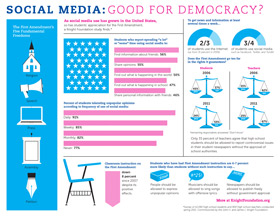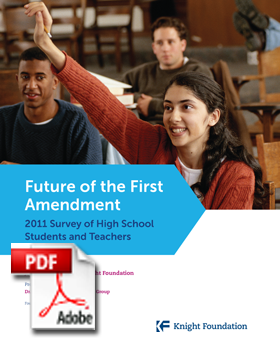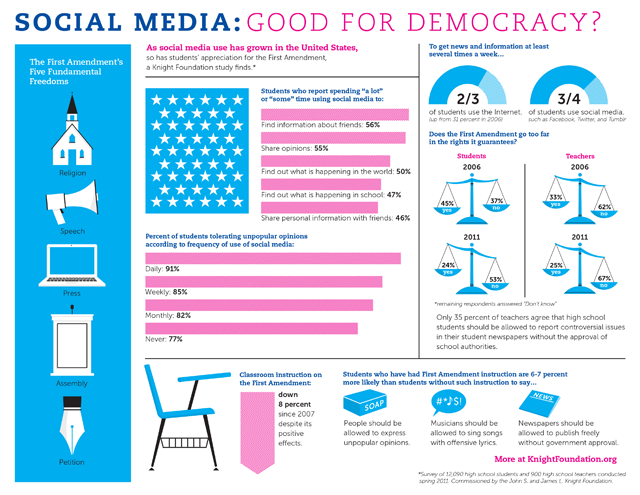
Information graphic: Click to Enlarge.
Credit: Column Five Media.

On Dec. 15, 1791, with the ratification of the Bill of Rights, the First Amendment to the U.S. Constitution was etched into our national history:
“Congress shall make no law respecting an establishment of religion, or prohibiting the free exercise thereof; or abridging the freedom of speech, or of the press; or the right of the people peaceably to assemble, and to petition the Government for a redress of grievances.”
The words do not change, but how we interpret them does. The First Amendment’s five fundamental freedoms – religion, speech, press, assembly and petition – are hotly debated. During the past 220 years, courts have interpreted these freedoms in landmark legal cases, setting the standards for freedom of expression for each new American generation.
Since young people represent the future of public opinion, they are the real overseers of the future of the First Amendment.
This study, the fourth in the Future of the First Amendment series commissioned by the John S. and James L. Knight Foundation, hopes to shed some light on that question.
In 2004, 2006, 2007 and now 2011, the foundation funded national surveys looking at what high school students know of and think about America’s constitutional rights to free expression. These studies have looked at how teachers, parents, the high school curriculum, and the media influence student attitudes toward free expression rights in America.
The studies began after surveys of American adults conducted by The Freedom Forum showed that even modern-day support for the First Amendment is neither universal nor stable. In the wake of the 2001 terrorist attacks, support for the First Amendment plummeted. Suddenly, the nation was almost evenly split on the question of whether or not the First Amendment “goes too far in the
rights it guarantees.’’ Not until 2004 did America’s support for the First Amendment return to pre 9-11 levels.
The surprising finding in the first Knight survey, in 2004, was that high school students tended to express little appreciation for the First Amendment. Nearly three-fourths said either they don’t know how they feel about it or they take it for granted. That finding has remained distressingly constant over the years, despite the introduction of Constitution Day in the nation’s schools that year, setting aside Sept. 17 for civics instruction. The 2006 study showed that despite increased teaching, more students thought the First Amendment, as a whole, goes too far in the rights it guarantees. Half the students in the 2007 study had never heard of Constitution Day.
Media use also was measured in 2007. Despite a popular belief that teens do not care about news, the study showed they do stay informed via digital media, and parents and peers had more influence than teachers on student media choices. This year’s survey confirms that finding.
This report presents the findings from a survey of 12,090 high school students and 900 high school teachers conducted in the Spring of 2011. It is authored by Dr. Kenneth Dautrich, a senior researcher at The Pert Group. Dautrich, who is also a professor at the University of Connecticut, recently published The Future of the First Amendment: Digital Media, Civic Education and Free Expression Rights in the Nations’ High Schools, a 2008 book analyzing the findings from the first three surveys. He has also authored The First Amendment and the Media in the Court of Public Opinion, which explores the dynamics of public attitudes about free expression rights.
Since Dr. Dautrich’s studies began, the dawning of a new digital age in communications has dramatically changed how people consume news and information. Internet news sources have proliferated, as have social networking sites, mobile technologies, and many other digital media sources. The changing media and communications environment affects us all, but perhaps none more than those who are in their most formative years of learning – high school students.
This 2011 Future of the First Amendment study focuses in particular on how the emerging digital media environment influences student orientations regarding free expression rights.
(Eric Newton, senior adviser to the president at the John S. and James L. Knight Foundation, has collaborated with Dr. Dautrich on the four Future of the First Amendment surveys.)
See also previous years of FoFA research: 2007 Report | 2006 Report | 2004 Report.
